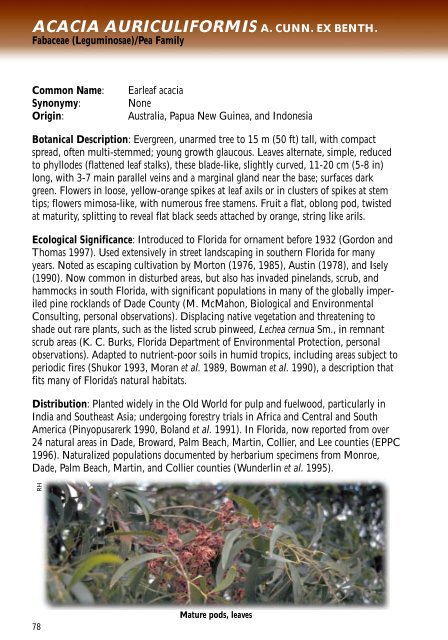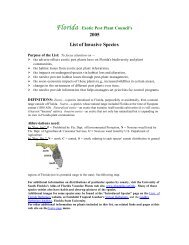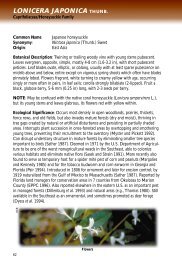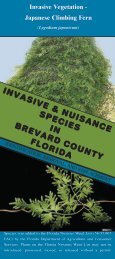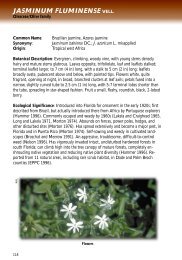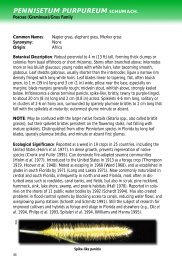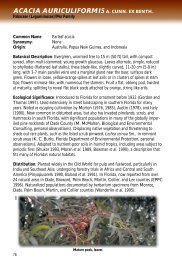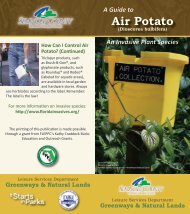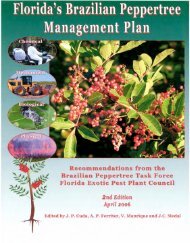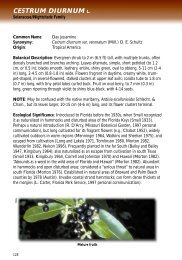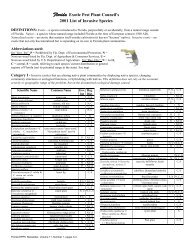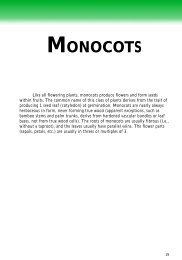DICOTS - Florida Exotic Pest Plant Council
DICOTS - Florida Exotic Pest Plant Council
DICOTS - Florida Exotic Pest Plant Council
Create successful ePaper yourself
Turn your PDF publications into a flip-book with our unique Google optimized e-Paper software.
Acacia auriculiformis A. Cunn. ex Benth.<br />
Fabaceae (Leguminosae)/Pea Family<br />
Common Name: Earleaf acacia<br />
Synonymy: None<br />
Origin: Australia, Papua New Guinea, and Indonesia<br />
Botanical Description: Evergreen, unarmed tree to 15 m (50 ft) tall, with compact<br />
spread, often multi-stemmed; young growth glaucous. Leaves alternate, simple, reduced<br />
to phyllodes (flattened leaf stalks), these blade-like, slightly curved, 11-20 cm (5-8 in)<br />
long, with 3-7 main parallel veins and a marginal gland near the base; surfaces dark<br />
green. Flowers in loose, yellow-orange spikes at leaf axils or in clusters of spikes at stem<br />
tips; flowers mimosa-like, with numerous free stamens. Fruit a flat, oblong pod, twisted<br />
at maturity, splitting to reveal flat black seeds attached by orange, string like arils.<br />
Ecological Significance: Introduced to <strong>Florida</strong> for ornament before 1932 (Gordon and<br />
Thomas 1997). Used extensively in street landscaping in southern <strong>Florida</strong> for many<br />
years. Noted as escaping cultivation by Morton (1976, 1985), Austin (1978), and Isely<br />
(1990). Now common in disturbed areas, but also has invaded pinelands, scrub, and<br />
hammocks in south <strong>Florida</strong>, with significant populations in many of the globally imperiled<br />
pine rocklands of Dade County (M. McMahon, Biological and Environmental<br />
Consulting, personal observations). Displacing native vegetation and threatening to<br />
shade out rare plants, such as the listed scrub pinweed, Lechea cernua Sm., in remnant<br />
scrub areas (K. C. Burks, <strong>Florida</strong> Department of Environmental Protection, personal<br />
observations). Adapted to nutrient-poor soils in humid tropics, including areas subject to<br />
periodic fires (Shukor 1993, Moran et al. 1989, Bowman et al. 1990), a description that<br />
fits many of <strong>Florida</strong>’s natural habitats.<br />
Distribution: <strong>Plant</strong>ed widely in the Old World for pulp and fuelwood, particularly in<br />
India and Southeast Asia; undergoing forestry trials in Africa and Central and South<br />
America (Pinyopusarerk 1990, Boland et al. 1991). In <strong>Florida</strong>, now reported from over<br />
24 natural areas in Dade, Broward, Palm Beach, Martin, Collier, and Lee counties (EPPC<br />
1996). Naturalized populations documented by herbarium specimens from Monroe,<br />
Dade, Palm Beach, Martin, and Collier counties (Wunderlin et al. 1995).<br />
RH<br />
78<br />
Mature pods, leaves


